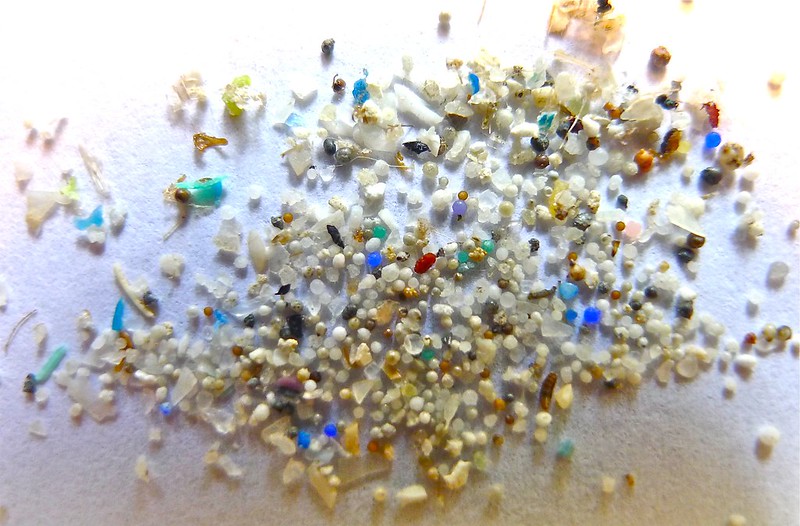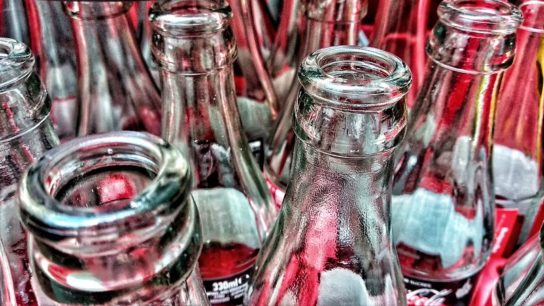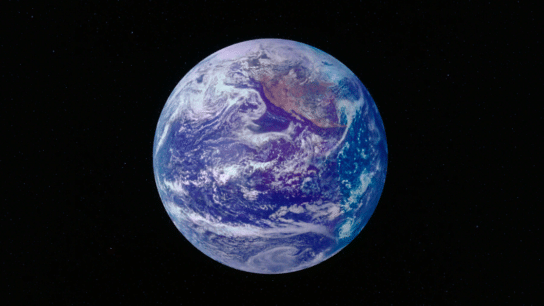In recent years, microplastics have been appearing in news headlines with the same creeping ubiquity with which they permeate our everyday lives and the natural world. Microplastics are defined as fragments of plastic smaller than 5mm and larger than 1 micron (1/1000th of a millimetre) in length, and their impact as one of the most common and pervasive pollutants on Earth is only just beginning to be subject to rigorous investigation.
—
Common examples of microplastics include materials such as glitter, microbeads and fragments from larger pieces of plastic debris, as well as from items of clothing. Over a matter of decades, these substances have become widespread in bodies of water, the digestive systems of wildlife, in the food we eat and in the air we breathe. The ingestion of microplastics by marine wildlife means that the substances have ‘the potential to bioaccumulate and threaten ecosystem health’, and can introduce harmful organic substances into the food chain.
An investigation conducted by researchers from the Ellen MacArthur Foundation, the Universities of Oxford and Leeds and Common Seas, discovered that the estimated 11 million tonnes of plastic dumped into the world’s oceans in 2016 could increase nearly threefold to 29 million tonnes every year by 2040. A crucial factor in the projected increase, the researchers state, is the prospected doubling of the volume of plastic on the market by 2040 if governments and businesses do not take preventative action. Meanwhile, researchers from the University of Manchester found that urban ‘hotspots’ in the north-west of England contained the highest concentrations of microplastics in their study, including a section of the River Tame in Denton which contained over 500 000 plastic particles per square metre.
The risks posed to organisms found in rivers are further illustrated in a study by Royal Holloway, University of London, which focused on the River Thames. According to the study, some 94 000 fragments of microplastics flow down certain sections of the river every second, a level which exceeds that of rivers such as the Danube and the Rhine in Europe. The bodies of crabs inhabiting the Thames were found to contain microplastic fragments, and 75% of the river’s European flounder population showed evidence of microplastic ingestion. Researchers also reported evidence of microplastics in 80% of London’s tap water.
The fact that these substances do not decompose means that the uncontrollable accumulation of microplastics on the planet is already a reality. Plastic production is expected to increase from today’s 300 million metric tonnes to 33 billion metric tonnes per year by 2050. Despite the gloomy outlook, however, there are several steps humankind can take to tackle the problem. The most significant of these is the need to dramatically reduce the use of single-use plastic items and increase recycling. In Europe, however, only 30% of plastic is recycled, and only 9% in the USA is recycled. The figure for Southeast Asia is also 9%. China has stopped importing plastic waste intended for landfill in the USA; therefore the USA needs to develop recycling capacities, in order to deal with the increased volume of plastic waste that would previously have been imported to China. A 2020 Greenpeace report found that just 14% of the nation’s recycling facilities can process containers commonly used in takeout food, fruit and baked goods. Just 11% can recycle plastic cups; 4% plastic bags and 1% can process plastic plates, cutlery and straws.
A long-term solution would be to develop new methods to break plastic down and more eco-friendly materials, such as biodegradable plastics. While some plastics are labelled as biodegradable, they can only be broken down by extremely high temperatures. One problem, however, is that the substances needed to create fully biodegradable plastics – polymers that can degrade into carbon, oxygen and other elements in water or soil – would not be useful as food packaging, for example. While this kind of biodegradable plastic could potentially be used for quick-use products such as plastic cutlery or food wrappers, it could not be used to replace all substances which cause microplastic particles to break off.
There has been evidence to show that certain aquatic organisms can break down microplastics that enter their systems. However, certain polymers, such as the polyethylene used in plastic shopping bags or polystyrene, are more difficult to break down. It seems that the first steps to tackle this problem lie in better quality waste-management facilities and more investigation into how polymers can be broken down. If the problem is not brought under control soon, humankind could be facing a future saturated in microplastics.
You might also like: Are Microplastics Harmful And How Can We Avoid Them?
Featured image by: Oregon State University

















